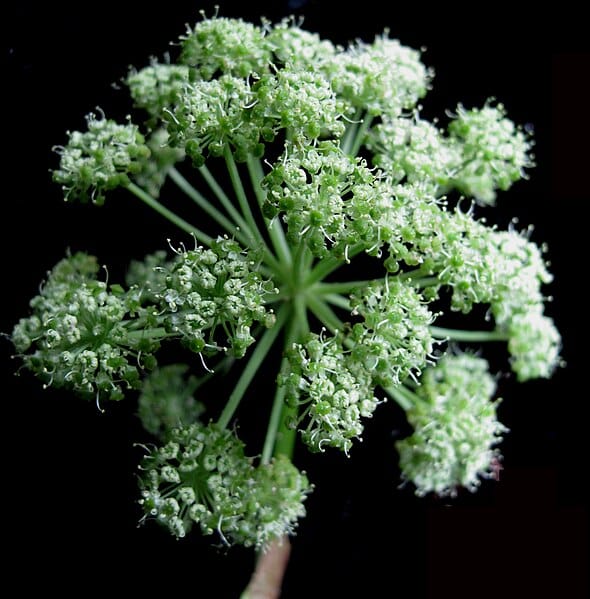Angelica Seedling Emergence: What to Expect
The journey of an angelica plant begins with germination. After the seed sprouts, the first structures to emerge are the cotyledons. These are the seed leaves, not true leaves. They are often oval or rounded in shape. Cotyledons usually appear fleshy. Their color is typically a light green. They may sometimes have a slightly yellowish tinge. These cotyledons are responsible for nourishing the young seedling. They provide energy until true leaves develop. They look different from the later true leaves. Their function is purely to sustain the initial growth. This emergence typically occurs within a week or two after sowing, depending on the conditions. It’s important to note what do angelica seedlings look like at this stage to avoid any confusion.
The cotyledons of angelica seedlings are usually quite small. They are typically smooth and without any serrations. They are simple in form. Unlike the complex true leaves that will follow, these seed leaves are generally uniform. The cotyledons act as a temporary food supply. They help the new plant establish itself. As the true leaves appear, the cotyledons will eventually wither and fall away. This is a normal part of the plant’s development cycle. Understanding this early stage of growth is key to successful identification. It can also help with the subsequent plant care. What do angelica seedlings look like in their cotyledon phase is crucial. This helps distinguish them from other plants in the early growth. The plant will then move into the true leaves stage after this.
Recognizing True Leaves: The Next Growth Stage
Following the emergence of cotyledons, the first true leaves of angelica seedlings begin to develop. These leaves mark a significant step in the plant’s growth. The true leaves differ considerably from the initial seed leaves. What do angelica seedlings look like at this stage? Their true leaves typically appear as compound leaves. This means they consist of multiple leaflets arranged on a central stem. The leaflets are generally ovate to lanceolate in shape. This indicates they are a bit egg-shaped or spear-shaped. Their edges are often serrated or toothed. This gives them a characteristic jagged appearance. The color of these leaves is typically a vibrant green. Sometimes, it may exhibit a slightly paler hue when young. The surface of the leaf is generally smooth but may have slight veining. This contributes to the overall texture. At this stage, the plant begins to look more like the adult form it will eventually become.
Specific features of these leaves are very useful for identification. Unlike the simple rounded or oval cotyledons, the true leaves are more complex. The arrangement of leaflets, their jagged edges, and their bright green color are good indicators. They help distinguish young angelica plants from others. These features are more pronounced than in many common seedlings. The first true leaves of angelica are not just larger than the cotyledons. They are also more detailed. They have a distinct texture and structure. What do angelica seedlings look like compared to other similar plants? The developing leaves become a strong identifier at this stage. The early stem begins to show distinct characteristics too. It starts as a thin, green stalk. It becomes more robust as the plant grows. The true leaves emerge from this central stem. This adds to the overall identifying features of a young angelica plant.
The progression from simple seed leaves to compound true leaves is a critical stage. This stage allows an observer to confidently identify young angelica plants. These leaves are essential for the plant. They help with photosynthesis. They convert sunlight into energy for the plant’s development. Observing their shape, edge, and color, and noticing their compound structure are crucial. These details help discern the plant’s true identity. What do angelica seedlings look like to stand out? This development of the first true leaves is an important time. It’s a stage to closely examine. It helps anyone interested in growing or observing them. The appearance of these true leaves signals the start of a more robust growth phase. It also provides essential keys for correct identification of angelica.
How to Differentiate Angelica Seedlings from Similar Plants
Distinguishing angelica seedlings from other plants, especially those in the Apiaceae family like carrots, can be tricky. What do angelica seedlings look like, and how do they differ? Carrot seedlings often have very fine, feathery leaves almost immediately. Young angelica, in contrast, will initially display rounded cotyledons. Once true leaves emerge, these are typically broader and more coarsely toothed than carrot leaves. The first true leaves of angelica will be distinctly different from the initial cotyledons. They are usually a medium green, with edges that have irregular teeth. These leaves tend to grow from a central point on the stem. They create a somewhat circular pattern. Observing the leaf shape and the way they emerge from the stem helps to identify angelica.
Another common point of confusion is between angelica and certain common weeds. Some weeds have rounded leaves that appear similar to the cotyledons of angelica, but these usually grow in a more disorganized fashion. Angelica seedlings exhibit a more structured growth pattern. It’s also important to observe the stem. Young angelica has a smooth, green stem. This stem is generally thicker than those of similar-looking weeds. Pay close attention to how the leaves attach to the stem and the overall structure. This will provide additional clues. The color of the stem is also something to note, as weeds sometimes have stems with a reddish tint or fine hairs. What do angelica seedlings look like? The combination of broad, toothed leaves, smooth, green stem and circular growth pattern set them apart.
Also consider the overall leaf texture and color. Angelica leaves tend to be more substantial. They also exhibit a deeper green compared to many other seedlings. Unlike some weeds which may have a dull or pale green color. Look closely at the edges of the leaves as well, as the coarseness of the toothing on young angelica leaves is a good identifying characteristic. Careful attention to these subtle differences, will increase your confidence in accurate identification. What do angelica seedlings look like? They have a robust appearance with distinct leaf shapes, growth patterns and stem characteristics.
The Importance of Early Angelica Identification
Accurate identification of angelica seedlings is crucial for several reasons. Firstly, some Angelica species, like Angelica archangelica, have notable medicinal and culinary applications. The roots, stems, and leaves of these plants are used in traditional herbal medicine. They also add unique flavor to various dishes and beverages. Knowing what do angelica seedlings look like ensures that the correct species are harvested for these purposes. Misidentification could lead to using a plant that doesn’t offer the same benefits. Alternatively, it could result in the consumption of something undesirable.
Secondly, many plant families include species that are similar to angelica at the seedling stage. This is particularly true within the Apiaceae family, which includes carrots, parsley, and hemlock. While some of these relatives are harmless or even useful, others are highly toxic. Hemlock, for example, is deadly poisonous, making it extremely important to tell it apart from angelica. Careful attention must be given to what do angelica seedlings look like to avoid accidental poisoning. Distinguishing them is not just for the sake of their uses, but also for safety and to prevent harm. Early and correct identification is essential to ensure that any gathered plant is the correct one.>
Finally, recognizing what do angelica seedlings look like helps in the proper cultivation of the plant. Understanding the specific environment where angelica thrives helps avoid planting them in unsuitable places. This knowledge is key, particularly for those who grow angelica for their own gardens or for commercial purposes. By identifying the plant in its early stages, you can ensure optimal conditions for its development into a mature and useful plant. Habitat considerations, including the level of light and soil moisture, are also important for angelica seedling ID. These factors can affect how they grow, so early identification is a vital step in nurturing healthy plants and ensuring a safe environment for humans and the local ecosystem.
Angelica Seedling Size and Growth Rate
The size of angelica seedlings varies considerably as they develop. Initially, after emergence, the cotyledons are small, typically just a few millimeters across. These seed leaves are often followed relatively quickly by the first true leaves. At this stage, seedlings may still only be an inch or two in height. The initial growth phase is somewhat rapid, with the plants focusing on root establishment and leaf development. Within the first few weeks, you might see the seedling grow to about 2 to 4 inches tall. During this phase, it is crucial to understand what do angelica seedlings look like in order to not mistake them with other similar seedlings. Generally, they will show a relatively quick increase in size, provided that they are given appropriate conditions for growth. The expansion in size during this initial period is a foundation for future growth, therefore making the plant ready for maturity.
Angelica seedlings will continue to grow larger through the first couple of months. You can expect them to reach several inches in height with more fully developed true leaves. A seedling at the two-month mark may reach about 6 to 10 inches in height. However, their growth rate can vary depending on factors like sunlight, water, and soil. Regular observation is important. This process helps in learning what do angelica seedlings look like at the different growth stages. Remember, these are just typical sizes; the actual growth can be slightly different. It is important to understand that the overall health of the seedling can greatly impact size at this stage. This stage will determine the future structure of the plant.
The overall growth of young angelica seedlings is dependent on the external conditions. Proper hydration and adequate light are essential for healthy growth. If the conditions are ideal, then seedlings tend to grow faster and larger within the specified period. It is important to consider these stages when understanding what do angelica seedlings look like at a given point of time. The variations within these sizes should be taken into account, since the seedlings can look different across regions. This will help in properly taking care of angelica plants. By observing these growth stages, it’s possible to better ensure healthy development.
Observing Angelica’s Root Development
While often hidden from view, the root system of young angelica plants plays a crucial role in their establishment and growth. Typically, angelica seedlings develop a taproot system. A taproot is a primary root that grows vertically downwards. It’s often thicker than the secondary roots. These secondary roots branch out from the taproot. This system helps anchor the plant firmly in the soil. It also allows access to deeper water and nutrients. The taproot is usually a creamy-white color and it may appear slightly fleshy in texture. However, it’s important to note, that the root system is usually not a key identifier when trying to determine what do angelica seedlings look like. It requires uprooting the seedling. This can cause damage to the delicate young plant.
Though the root system isn’t generally used for identification, understanding its structure can offer insight into the plant’s overall health and needs. The taproot enables the plant to withstand drought conditions. It also helps the plant uptake vital minerals from the soil. As the plant matures, the taproot will grow more substantial. This contributes to the plant’s robust stature. Observing the root, if done carefully, can show if the seedling is healthy and well-established. For those interested in the full lifecycle of the plant, understanding what do angelica seedlings look like below the ground is useful. A healthy root system is crucial to the plant’s overall vigor and subsequent growth.
However, it must be emphasized that identifying angelica seedlings through their roots is generally not recommended. The above-ground features are the best way to identify them. Focus should be on the leaves, stems, and overall appearance. What do angelica seedlings look like? They have cotyledons, then true leaves with specific shapes and colors. These external characteristics provide reliable information. Using external visual cues reduces any accidental disturbance to the young plant. The focus should remain on the more accessible features for accurate identification and care.
Understanding Environmental Factors Affecting Seedling Appearance
Environmental conditions significantly influence what do angelica seedlings look like and their overall health. Light, soil moisture, and temperature play crucial roles. These factors can alter the seedlings’ appearance and vigor. For instance, seedlings grown in low light conditions tend to be etiolated. This means they will have elongated stems and pale leaves. They reach for the light, becoming weak and less robust. In contrast, seedlings in full sun develop sturdier stems and more vibrant, green leaves. These plants also tend to grow more compactly. Therefore, the availability of light is critical in shaping the early growth of angelica seedlings.
Soil moisture is another key factor. Angelica seedlings thrive in consistently moist soil. However, excessively wet conditions can lead to root rot. This will weaken or kill the young plants. Conversely, if the soil is too dry, seedlings can become stunted. Their leaves may wilt or dry out. Optimal soil moisture ensures the roots can effectively absorb water and nutrients. This is essential for healthy growth. Additionally, temperature affects the rate of germination and seedling development. Warmer temperatures promote faster growth. Cooler temperatures slow the process. Seedlings exposed to extreme temperature fluctuations, such as very cold nights followed by very hot days, may experience stress. This will affect their growth and appearance, making what do angelica seedlings look like to vary considerably.
Understanding how these environmental factors affect seedlings can help in identifying them accurately, but also in providing the best possible care. For example, seedlings grown in shaded areas may look different compared to those grown in full sun. They might be taller and paler with less developed leaves. This will change what do angelica seedlings look like as well as their growing pattern. Therefore, observing seedlings in their specific environment is crucial to understanding their growth habit and health. It allows gardeners to adjust conditions, ensuring they grow into robust angelica plants.
Care for Young Angelica: Ensuring Healthy Growth
Providing the right care is essential for young angelica seedlings to develop into robust plants. These seedlings, particularly in their early stages, require specific conditions to thrive. Proper watering techniques are vital; aim for consistent soil moisture without waterlogging, which can lead to root rot. A well-draining soil mix, rich in organic matter, is ideal for angelica. This type of soil promotes healthy root development and nutrient absorption. Light levels play a crucial role too. Young angelica plants generally prefer partial shade, especially during the hottest parts of the day. Direct, intense sunlight can scorch their delicate leaves. Observing what do angelica seedlings look like under different light conditions is important; you’ll notice they might appear more compact under brighter conditions.
When transplanting, carefully lift the seedlings, making sure to minimize root disturbance. Choose a location that provides adequate space for the mature plant. The ideal spacing depends on the specific angelica variety. Angelica archangelica, for example, can become quite large. The young plants will continue to develop their distinct features as they grow. Understanding what do angelica seedlings look like through all their early stages helps provide the right conditions. Regular monitoring for pests or diseases is also important. Addressing any issues promptly can prevent significant problems later on. Fertilizing the seedlings with a balanced, diluted solution can encourage healthy leaf and stem growth. Be sure to follow fertilizer instructions carefully.
With the right care, you can expect your young angelica to mature into a magnificent plant. From those tiny cotyledons to their first true leaves, each stage is a beautiful part of the plant’s lifecycle. Appreciating what do angelica seedlings look like in the beginning is vital for success. They will transform into beautiful mature plants, and potentially offer culinary or medicinal value, depending on the type of angelica you have. By providing the correct levels of moisture, light, soil quality and gentle handling during transplantation, they will thrive and flourish. Cultivating these seedlings will provide great satisfaction, knowing that you are supporting their growth into their full potential. You will soon be rewarded with vigorous, mature angelica plants.




